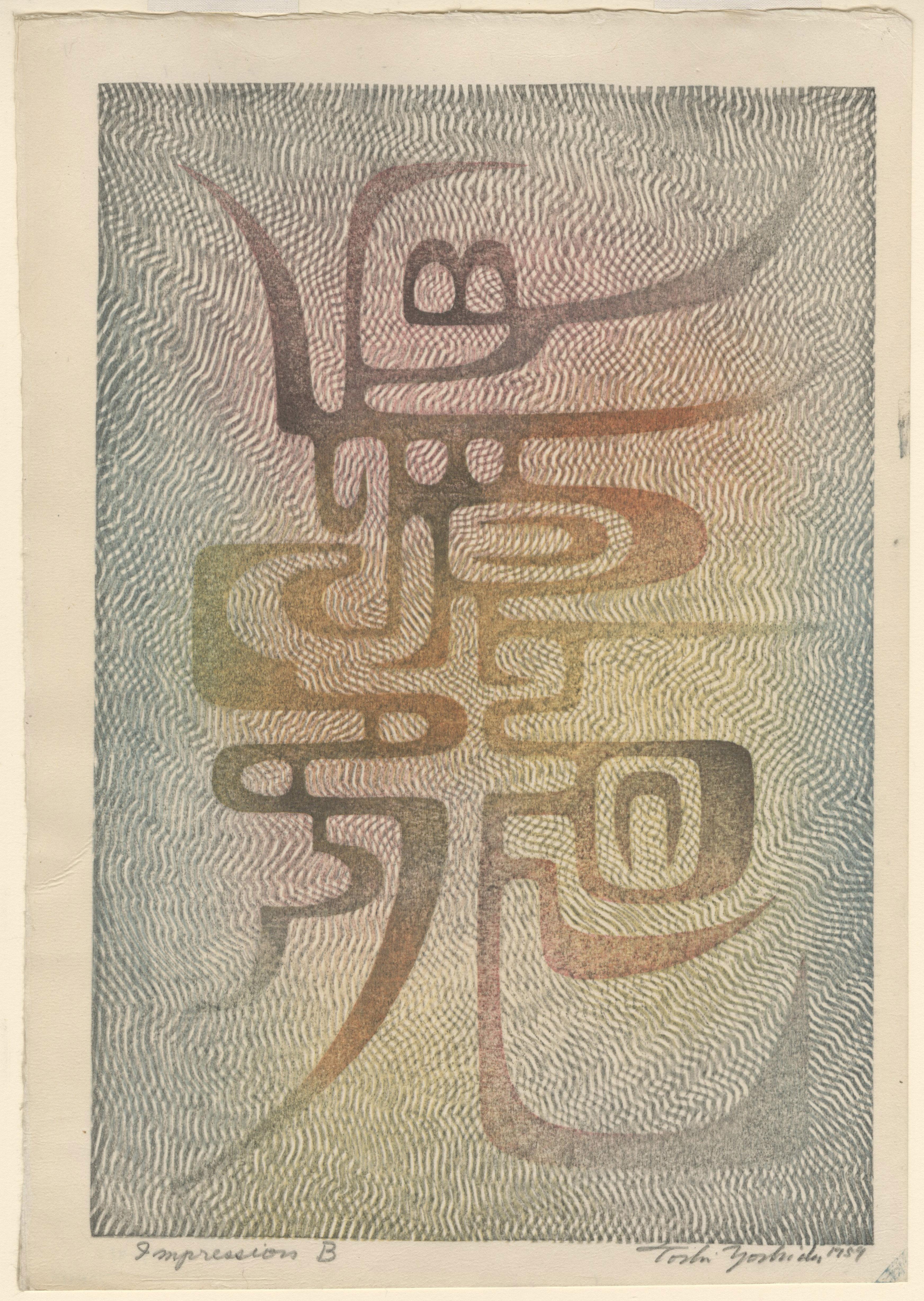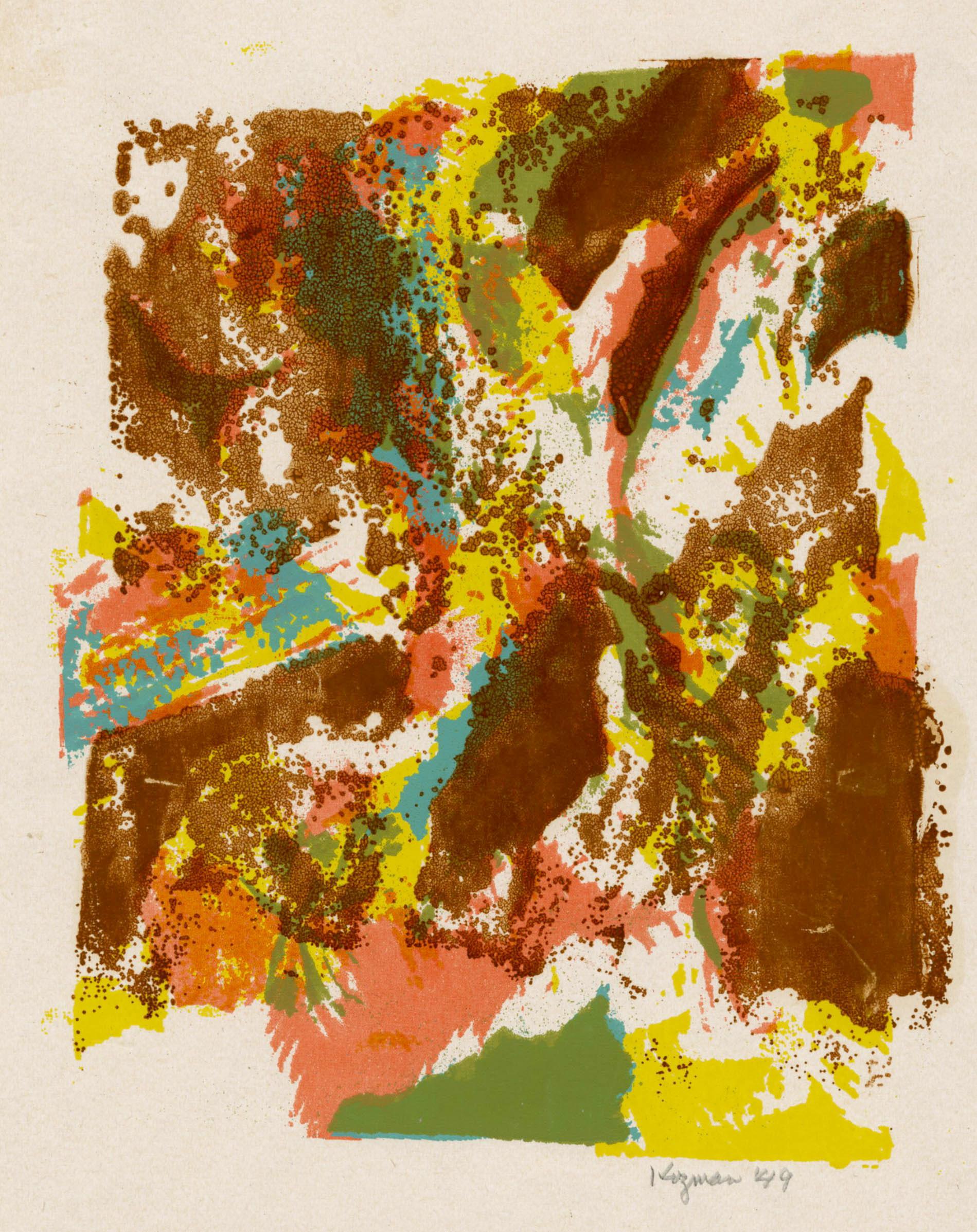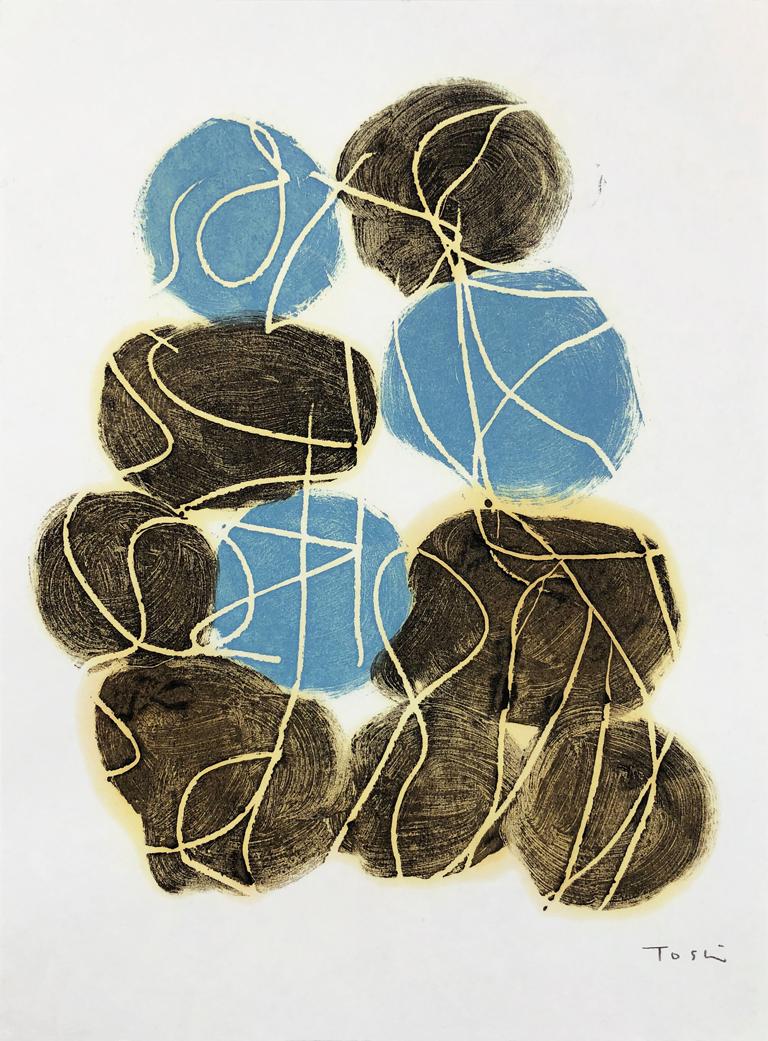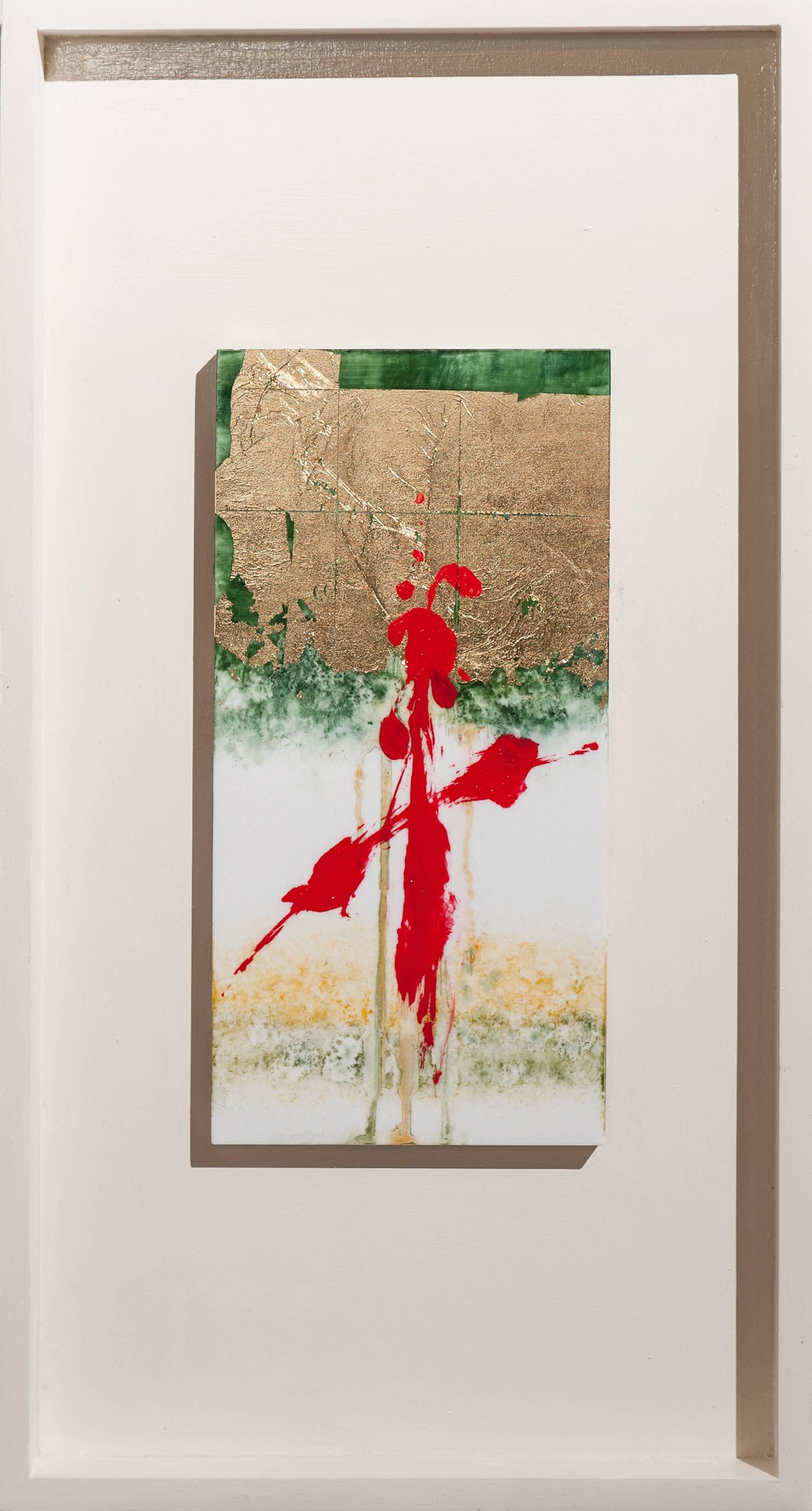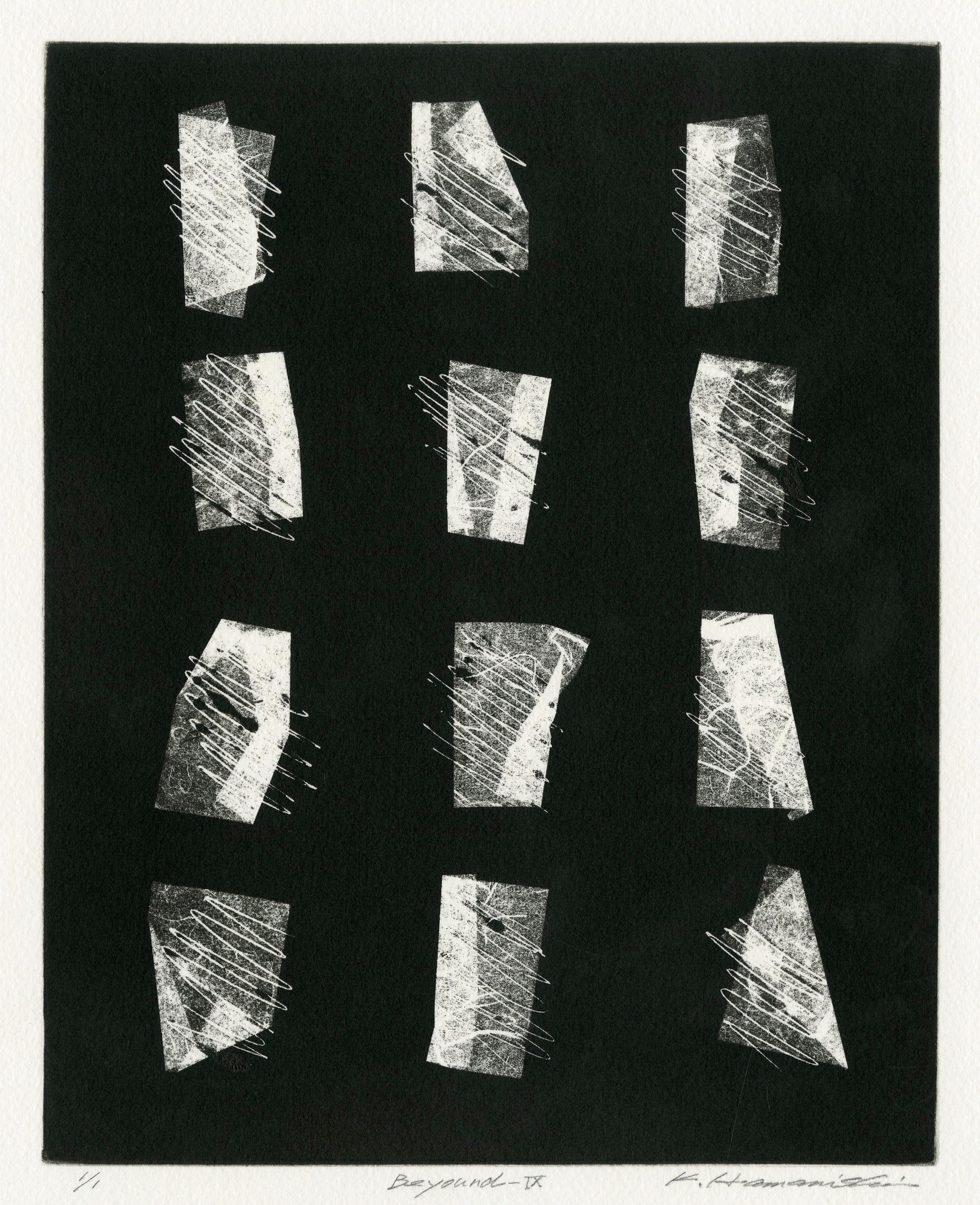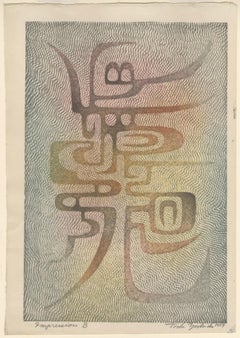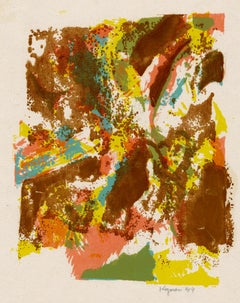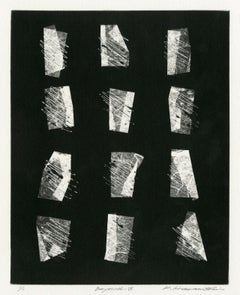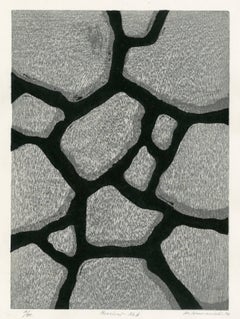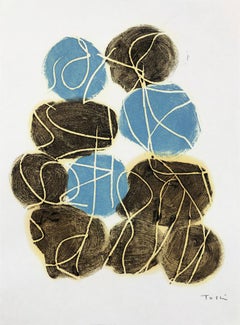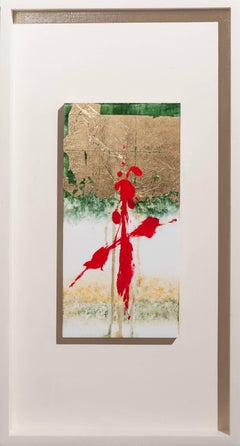Want more images or videos?
Request additional images or videos from the seller
1 of 7
Toshi Yoshida 1Impression B1959
1959
$800
£619.93
€703.49
CA$1,146.61
A$1,259.20
CHF 648.19
MX$15,066.69
NOK 8,252.86
SEK 7,734.16
DKK 5,253.97
About the Item
Impression B
Color woodcut, 1959
Signed and dated lower right (see photo)
Titled lower left (see photo)
A trial proof, prior to the edition of 100, signed and numbered
Condition: Excellent
Image size: 14 1/2 x 9 3/4 inches
Provenance: Estate of the artist
by decent to his heirs
"Printmaker and painter Toshi Yoshida was born on July 25, 1911, into the respected Yoshida family of artists of Tokyo, Japan. Father Hiroshi was a celebrated landscape painter and printmaker, and mother Fujio established herself as the first female Yoshida artist as well as an Abstract artist later in her career. Younger brother Hodaka was an Abstract printmaker whose style, completely separate from his family's historic traditional bent, later influenced Toshi. Hodaka's wife Chizuko would become a pioneering female Japanese artist whose own exploration of Surrealism and Abstraction challenged the status quo. Toshi, however, as the eldest sibling, was expected to follow in his father's footsteps, and from an early age he was trained by Hiroshi in his studio.
Unable to attend formal schooling due to the polio-induced paralyzation of his leg, Toshi would instead help with his family's printmaking studio and go on sketching trips with Hiroshi. As he got older, these trips would include India and Southeast Asia, working from morning to night taking night trains to get from one destination to another. Among Toshi's favorite subjects were the animals he discovered along the way. However, these trips ended as Japan entered military dictatorship in the mid 1930s, and artists whose work showed signs of Western influence were barred from exhibiting. At this time, Toshi left Japan for China and Korea, where he would remain for the duration of the war. He stuck to patriotic themes to remain in business, and after the end of World War II, as Japan struggled to recover from wartime economic depression, he earned his living creating traditional Japanese woodcut landscapes for American personnel.
Toshi Yoshida took up traveling once more, going as far as Antartica. He began exhibiting internationally for the first time in his career, as well, including in including in London, China, the US and Mexico, and was invited to lecture on printmaking techniques at various intitutions.
After the death of his father in 1950, Toshi began to stretch his stylistic horizon to include Abstraction, influenced by his younger siblings. Between 1954 and 1973 Toshi had created around 300 non-objective prints. In 1971 he began working as a children's book illustrator, going back to his roots as a renderer of animals and exotic landscapes, and eventually abandoned Abstraction to focus his energy exclusively on illustration. In 1980 he opened his own printmaking school in the Nagano Prefecture, attracting students from all over the world, among them Micah Schwaberow, Carol Jessen, Karyn Young, and others who would go on to become successful woodblock printmakers.
Toshi Yoshida died of cancer on July 1, 1995 in Tokyo, Japan, just a few weeks shy of his 84th birthday."
Courtesy Annex Galleries
- Creator:Toshi Yoshida 1 (1911 - 1995)
- Creation Year:1959
- Dimensions:Height: 14.5 in (36.83 cm)Width: 9.75 in (24.77 cm)
- Medium:
- Movement & Style:
- Period:
- Condition:
- Gallery Location:Fairlawn, OH
- Reference Number:Seller: UK23421stDibs: LU14015913712
About the Seller
5.0
Recognized Seller
These prestigious sellers are industry leaders and represent the highest echelon for item quality and design.
Gold Seller
Premium sellers maintaining a 4.3+ rating and 24-hour response times
Established in 1978
1stDibs seller since 2013
825 sales on 1stDibs
Typical response time: <1 hour
Associations
International Fine Print Dealers Association
- ShippingRetrieving quote...Shipping from: Akron, OH
- Return Policy
More From This Seller
View AllImpression B
By Toshi Yoshida 1
Located in Fairlawn, OH
Impression B
Color woodcut, 1959
Signed and dated lower right (see photo)
Titled lower left (see photo)
A trial proof, prior to the edition of 100, signed and numbered
Condition: Excellent
Image size: 14 1/2 x 9 3/4 inches
Provenance: Estate of the artist
by decent to his heirs
"Printmaker and painter Toshi Yoshida was born on July 25, 1911, into the respected Yoshida family of artists of Tokyo, Japan. Father Hiroshi was a celebrated landscape painter and printmaker, and mother Fujio established herself as the first female Yoshida artist as well as an Abstract artist later in her career. Younger brother Hodaka was an Abstract printmaker whose style, completely separate from his family's historic traditional bent, later influenced Toshi. Hodaka's wife Chizuko would become a pioneering female Japanese artist whose own exploration of Surrealism and Abstraction challenged the status quo. Toshi, however, as the eldest sibling, was expected to follow in his father's footsteps, and from an early age he was trained by Hiroshi in his studio.
Unable to attend formal schooling due to the polio-induced paralyzation of his leg, Toshi would instead help with his family's printmaking studio and go on sketching trips with Hiroshi. As he got older, these trips would include India and Southeast Asia, working from morning to night taking night trains to get from one destination to another. Among Toshi's favorite subjects were the animals he discovered along the way. However, these trips ended as Japan entered military dictatorship in the mid 1930s, and artists whose work showed signs of Western influence were barred from exhibiting. At this time, Toshi left Japan for China and Korea, where he would remain for the duration of the war. He stuck to patriotic themes to remain in business, and after the end of World War II, as Japan struggled to recover from wartime economic depression, he earned his living creating traditional Japanese woodcut landscapes...
Category
1950s Abstract Abstract Prints
Materials
Woodcut
Untitled
By Myron Kozman
Located in Fairlawn, OH
Untitled
Screen print, 1941
Signed and dated in pencil lower right
From an unnumbered edition of 6
Condition: Excellent
Image size: 7 1/4 x 5 3/4 inches
Sheet size: 10 x 8 inches
Pr...
Category
1940s Abstract Abstract Prints
Materials
Screen
Beyound (sic) - IX
By Katsunori Hamanishi
Located in Fairlawn, OH
Beyond (sic) - IX
Mezzotint, n.d.
Signed, titled and numbered in pencil (see photos)
Edition: Unique impression (i/I)
Ninion and Sheldon Landy were major collectors of Hamanishi's works. They donated a large group of his mezzotints to Art Institute of Chicago, which formed the core of the exhibitions of his works at AIC in 2014 and again in 2019.
Condition: excellent
Plate/Image size: 9.75 x 7.75 inches
Sheet size: 12 1/2 x 9 5/8 inches
Provenance: Ninion and Sheldon Landy, Hamanishi's patrons
EXTREMELY RARE-UNIQUE
Katsunori Hamanishi
Born: 1949, Hokkaido
Medium: Mezzotint, with relief printing and metallic foil. Also a few woodblocks
Hamanishi studied painting and graduated from Tokai University with a degree in Art, in 1973. Since then, he has been living in the Tokyo area, where his primary focus is printmaking. Mezzotint is a variation of intaglio printing--an exacting and laborious process whereby ink is transferred from below the surface of the plate by use of a press. First, the entire copper plate is indented with a toothed steel rocker tool. Worked in all directions, this creates an even finely-grained texture over the surface of the plate. Each pit will hold ink and were the plate inked at this stage, it would print almost solid black.
To create the design the artist smoothes out some of the pits with a burnisher so they will hold less ink. Where highlights are required the plate is burnished and polished quite smooth. A wide range of tones are possible in mezzotint and the process can usually be recognized by a light design on a velvety black background. Hamanishi is internationally known for his mastery of this medium. He creates images with both subtle detail and dynamic composition that explore spatial relationships.
His genius is in balancing calm and meditative qualities with the energetic tensions of inanimate and natural objects. Early work had such things as pipes and branches wrapped with cloth, later rope, then straw. When he moved to a more rural area, rice fields became a common element. He has also been exploring the use of color and metallic leaf in his artwork. In 2005 Mr. Hamanishis began the Haze series exploring more abstract themes using the subtle differences between matte and black inks done in mezzotint and relief printing.
There is always a sense of mystery and intrigue in the complex mezzotint prints that come from Hamanishi’s deft hands. They compel the viewer to do a slow, thoughtful examination in order to fully absorb the vision the artist intends.
Exhibitions:
Worcester Art Museum, Massachusetts --2 person show with Hamaguchi
Ibiza Biennial, Spain--Grand Prize
Original Colored Graphic Print Triennial, Switzerland--Grand Prize
Cabo Frio International Print Biennial, Brazil--Grand Prize
CWAJ Print Show, Tokyo--Art Grant winner
Republic of China Print Exhibit--Gold Medal
Graphic Arts Council, Achenbach Foundation, San Francisco--commissioned print
Art Institute of Cleveland
University of Alberta, Edmonton, Canada--visiting artist
Shun-yo-Kai, Tokyo--prize winner
Bhara Bhavan International Print Biennale, India
Ren Brown...
Category
1980s Abstract Abstract Prints
Materials
Mezzotint
Festival No. 6
By Katsunori Hamanishi
Located in Fairlawn, OH
Festival No. 6
Color woodblock, 2002
Signed, titled and numbered in pencil (see photos)
Edition: 50 (10/50), see photo
Provenance:
Ninion and Sheldon Landy Collection, Donors to Art Inst. of Chicago
Hamanishi Exhibition, Oct. 12, 2013-January 5, 2014
Reference: Hamanishi Small 98
Condition: Excellent
Sheet: 12 1/4 x 9 1/8";
Image 10 1/2 x 7 1/2"
Katsunori Hamanishi
Born: 1949, Hokkaido
Medium: Mezzotint, with relief printing and metallic foil. Also a few woodblocks
Hamanishi studied painting and graduated from Tokai University with a degree in Art, in 1973. Since then, he has been living in the Tokyo area, where his primary focus is printmaking. Mezzotint is a variation of intaglio printing--an exacting and laborious process whereby ink is transferred from below the surface of the plate by use of a press. First, the entire copper plate is indented with a toothed steel rocker...
Category
Early 2000s Abstract Abstract Prints
Materials
Woodcut
Festival No. 6
By Katsunori Hamanishi
Located in Fairlawn, OH
Festival No. 6
Color woodblock, 2002
Signed, titled and numbered in pencil (see photos)
Edition: 50 (10/50), see photo
Provenance:
Ninion and Sheldon Landy Collection, Donors to Art Inst. of Chicago
Hamanishi Exhibition, Oct. 12, 2013-January 5, 2014
Reference: Hamanishi Small 98
Condition: Excellent
Sheet: 12 1/4 x 9 1/8";
Image 10 1/2 x 7 1/2"
Katsunori Hamanishi
Born: 1949, Hokkaido
Medium: Mezzotint, with relief printing and metallic foil. Also a few woodblocks
Hamanishi studied painting and graduated from Tokai University with a degree in Art, in 1973. Since then, he has been living in the Tokyo area, where his primary focus is printmaking. Mezzotint is a variation of intaglio printing--an exacting and laborious process whereby ink is transferred from below the surface of the plate by use of a press. First, the entire copper plate is indented with a toothed steel rocker...
Category
Early 2000s Abstract Abstract Prints
Materials
Woodcut
Untitled
By Shoichi Ida
Located in Fairlawn, OH
Untitled
molded mud-dried paper with collage elements, 1996
Signed and dated lower edge (see photo)
Annotated and titled verso
Sheet size: 24 x 7 inches
Provenance: Ralph Drake, fir...
Category
1990s Abstract Abstract Drawings and Watercolors
Materials
Mixed Media
You May Also Like
Untitled
Located in New York, NY
Woodblock print
Signed in pencil, recto
12 x 9 inches
This artwork is offered by ClampArt, located in New York City.
Category
21st Century and Contemporary Abstract Abstract Prints
Materials
Color
Price Upon Request
#5296
By Hiro Yokose
Located in Phoenix, AZ
oil and gold leaf on porcelain tile
Neoromantic painter Hiro Yokose fuses multiple layers of wax and oil paint to create mysterious, veiled landscapes illuminated with flashes of li...
Category
2010s Abstract Abstract Paintings
Materials
Gold, Gold Leaf
$3,000
Fly
By Takesada Matsutani
Located in Hollywood, FL
Artist: Takesada Matsutani
Title: Fly
Medium: Screenprint
Signed: Hand Signed
Edition: 13/175
Measurements: 23" x 28.5"
Year: 1971
Note: This piece is sold UNFRAMED
Condition:...
Category
1970s Abstract Abstract Prints
Materials
Screen
Untitled
Located in San Francisco, CA
This artwork "Utitled" c.2000 is a colors monotype on B.F.K Rives paper by American artist Phil Gallagher. It is hand signed and numbered 1/1 in pencil...
Category
21st Century and Contemporary Abstract Abstract Prints
Materials
Monotype
Origin-Beginning-6 (9/20)
By Seiko Tachibana
Located in Palm Springs, CA
One of seven images from the Origin-Beginning series.
Seiko Tachibana was born in Japan and completed her Masters of Art Education at Kobe University, Japan.
Her distinctive work b...
Category
21st Century and Contemporary Abstract Abstract Prints
Materials
Etching, Aquatint
Untitled IV, Abstract Encaustic and Sand Painting on Canvas by Juhachiro Takada
By Juhachiro Takada
Located in Long Island City, NY
Artist: Juhachiro Takada
Title: Untitled IV
Medium: Encaustic, Sand on Canvas, Signed in pencil
Paper Size: 10.5 x 12.5 inches
Frame Size: 19.5 x 20.5 inches
Category
1980s Abstract Abstract Paintings
Materials
Encaustic
More Ways To Browse
Toshi Yoshida
Yoshida Toshi
Alfred MANESSIER On Sale
Andy Warhol Sunset
Art Poster Helen Frankenthaler
Banksy Welcome Mat
Calder Ea
Calder Flowers
Calder Lithograph Balloons
Calder Lithograph Pyramids
Calder Mcgovern
Calder Pyramid Prints
Carlo Scarpa Print
Catherine Peet
Chandler Pastel
Chateau De Culan
Chihuly Lithograph
Christopher Wool Poster
